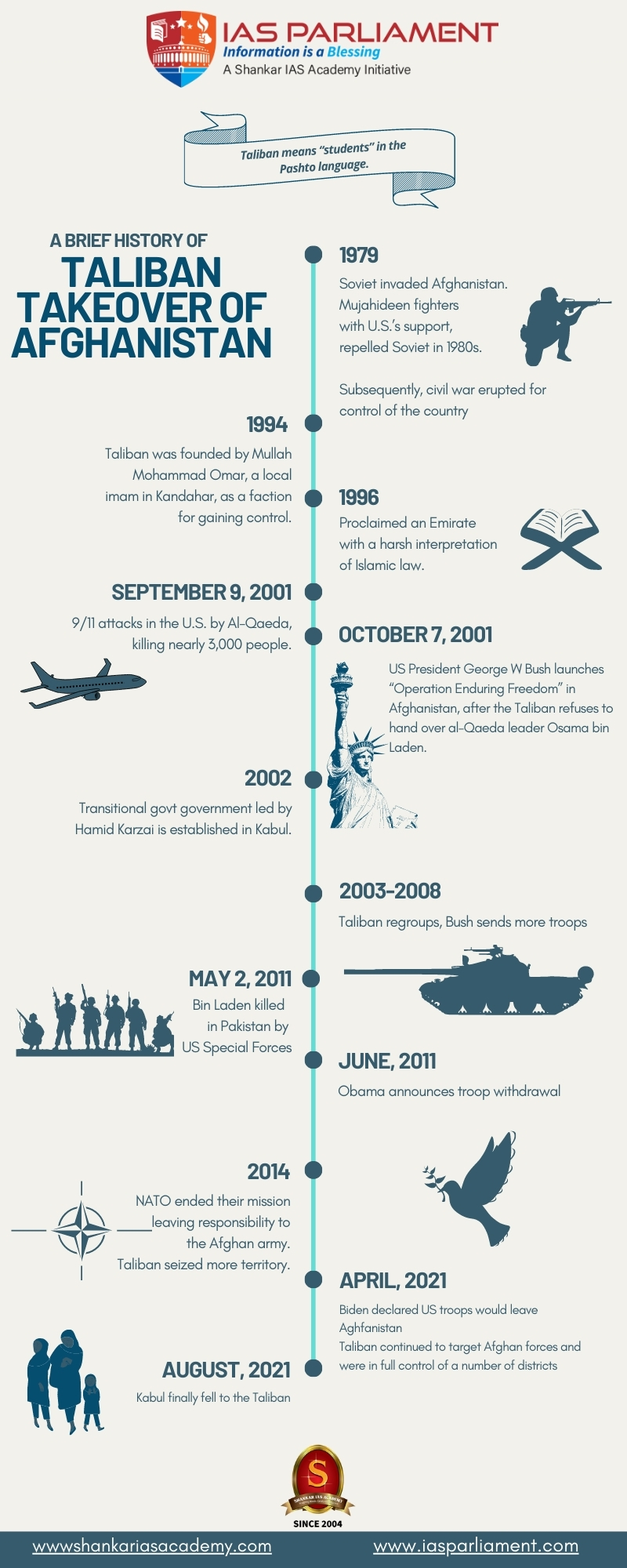Why in news?
With the withdrawal of the U.S. forces, the Taliban took control of Afghanistan’s capital Kabul, declaring end of war.
What led to the birth of the Taliban?
Taliban means “students” in the Pashto language.
- Soviet invaded Afghanistan in 1979.
- “Mujahideen” fighters (separatist group), with the U.S.’s support, repelled Soviet forces in the 1980s.
- Soviet withdrew in 1989 and the government collapse.
- Subsequently, civil war erupted for control of the country.
- Taliban was founded in 1994 by Mullah Mohammad Omar, a local imam in Kandahar, as a faction for gaining control.
- Afghans were weary of the mujahideen's excesses and infighting.
- Taliban rose to popularity due to successfully curbing corruption & lawlessness, making the roads and providing safety for commerce.
- Proclaimed an Emirate in 1996 with a harsh interpretation of Islamic law.
Public executions, Amputations, Men required to grow beards, Women had to wear the all-covering burka, Banned television, music and cinema, Disapproved of girls aged 10 and over going to school and Cultural abuses including the destruction of Bamiyan Buddha
- Pakistan, Saudi Arabia and UAE were the only three to recognise the Taliban government when it was in power [1996 – 2001].
Why did the U.S. come in?
- Sep 11, 2001 attacks in the U.S. by Al-Qaeda, killed nearly 3,000 people.
- Al-Qaeda’s leader Bin Laden was in Afghanistan, under the protection of the Taliban who refused to hand him over.
- The US intervened militarily; US-backed forces in the north swept into Kabul and conducted heavy airstrikes.
- The US -
- Removed the Taliban from power (who moved into remote areas)
- Vowed to support democracy and eliminate the terrorist threat
- NATO allies had joined the US and a new Afghan government took over in 2004.
How costly was the war (2001-2021)?
- Estimated 69,000 losses in the Afghan security forces
- Number of civilians and militants killed - about 51,000 each
- More than 20,000 US soldiers injured
- Afghanistan now has the third-largest displaced population in the world.
Why is the U.S. withdrawing now?
- Killed Osama bin Laden (2011 itself)
- Ousted Al-Qaida from Afghanistan.
- In 2014, NATO’s international forces ended their combat mission, leaving responsibility for security to the Afghan army.
What was the Taliban doing meanwhile?
- Since 2011, despite a continued international presence and billions of dollars of support, the Taliban regrouped and gradually regained strength in more remote areas.
- They were engaged in insurgency against the Afghan government and its Western allies.
- After 2014, Taliban seized more territory.
- Peace talks between the US and the Taliban started in 2018.
How did the peace talks fare?
- In February 2020 the two sides struck a peace deal in Doha.
- It committed the US to withdrawal and the Taliban to preventing attacks on US forces.
- Other promises included not allowing al-Qaeda or other militants to operate in areas it controlled and proceeding with national peace talks.
- However, the Taliban continued to target Afghan security forces and civilians.
- The agreement on a US withdrawal came in February 2020 in Qatar.
What is the recent happening?
- In April 2021, Biden, declared that all US troops would leave the country by Sept. 11 2021.
- Taliban stepped up its campaign to defeat the the government in May as foreign forces started to withdraw.
- With a few troops left, the capital Kabul finally fell to the Taliban.
- President Ghani flew out of the country stating to avoid any more bloodshed.
- Many Afghan leaders formally handed over power to the Taliban.
- The Taliban have now -
- Declared the war is over as Afghan forces surrendered and President fled the country.
- Installed themselves in the presidential palace with little resistance.
Why did the Afghan army fell so soon?

- Not effective without residual US air and ground support.
- Corruption and lack of local legitimacy.
- Lack of sound political and administrative backing.
- Soldiers don’t receive regular pay, and not properly supplied and equipped with.
A study in 2017 showed the Taliban were in full control of a number of districts
US intelligence assessment itself reported that the Afghan government could fall within 6 months of US departure.
Who will preside now?
- Decision will be taken after a consultation among top Taliban leadership.
- Likely President candidate - Mullah Abdul Ghani Baradar
- Taliban’s deputy commander and its most public face
- Chief negotiator
- Oversaw the signing of the agreement for the US troop withdrawal
What are the key concerns now?
- Fears of a worsening civil war in Afghanistan as the likely outcome.
- Return to the cruel and repressive practices as in Taliban’s previous regime [1996 – 2001].
What is the Taliban’s response to these fears?
- Denies claims that it would return to strict rule under the Islamic law
- Wants a “genuine Islamic system” for Afghanistan and build “an open, inclusive Islamic government”.
- Pledges for national peace talks
- Promises to make provisions for women’s and minority rights, in line with cultural traditions and religious rules
- However, there are alreadyy signs of the group prohibiting women from working in some areas, attending schools and universities, and leaving the house without a male escort.

Source: The Indian Express, The Guardian, BBC

